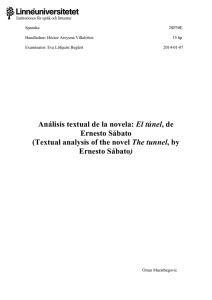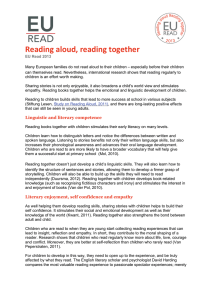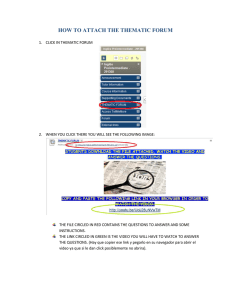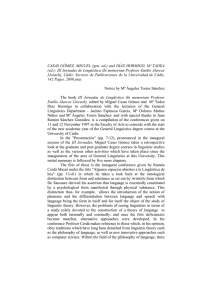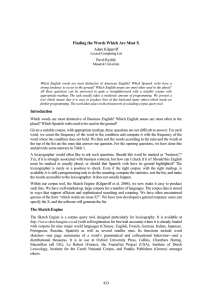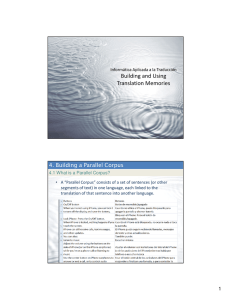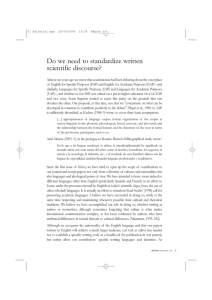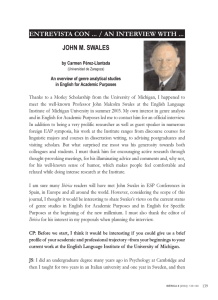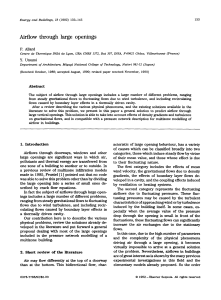Analyzing the Thematic Openings of Linguistic Journal Articles
Anuncio
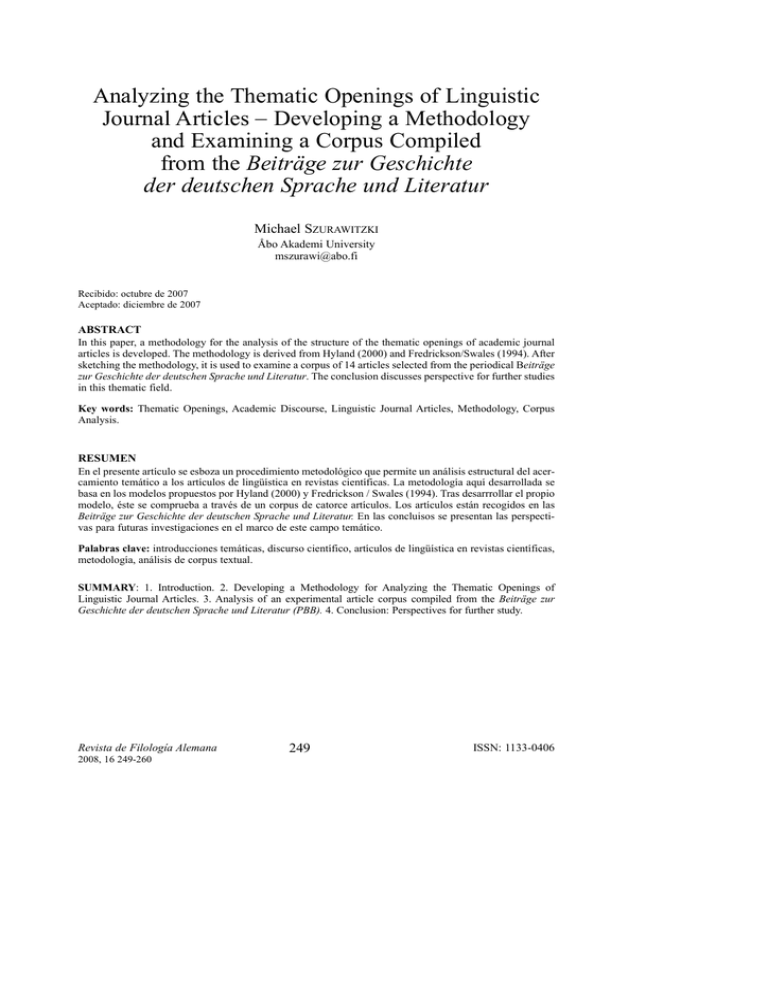
Analyzing the Thematic Openings of Linguistic Journal Articles _ Developing a Methodology and Examining a Corpus Compiled from the Beiträge zur Geschichte der deutschen Sprache und Literatur Michael SZURAWITZKI Åbo Akademi University [email protected] Recibido: octubre de 2007 Aceptado: diciembre de 2007 ABSTRACT In this paper, a methodology for the analysis of the structure of the thematic openings of academic journal articles is developed. The methodology is derived from Hyland (2000) and Fredrickson/Swales (1994). After sketching the methodology, it is used to examine a corpus of 14 articles selected from the periodical Beiträge zur Geschichte der deutschen Sprache und Literatur. The conclusion discusses perspective for further studies in this thematic field. Key words: Thematic Openings, Academic Discourse, Linguistic Journal Articles, Methodology, Corpus Analysis. RESUMEN En el presente artículo se esboza un procedimiento metodológico que permite un análisis estructural del acercamiento temático a los artículos de lingüística en revistas científicas. La metodología aquí desarrollada se basa en los modelos propuestos por Hyland (2000) y Fredrickson / Swales (1994). Tras desarrrollar el propio modelo, éste se comprueba a través de un corpus de catorce artículos. Los artículos están recogidos en las Beiträge zur Geschichte der deutschen Sprache und Literatur. En las concluisos se presentan las perspectivas para futuras investigaciones en el marco de este campo temático. Palabras clave: introducciones temáticas, discurso científico, artículos de lingüística en revistas científicas, metodología, análisis de corpus textual. SUMMARY: 1. Introduction. 2. Developing a Methodology for Analyzing the Thematic Openings of Linguistic Journal Articles. 3. Analysis of an experimental article corpus compiled from the Beiträge zur Geschichte der deutschen Sprache und Literatur (PBB). 4. Conclusion: Perspectives for further study. Revista de Filología Alemana 2008, 16 249-260 249 ISSN: 1133-0406 Michael Szurawitzki Analyzing the Thematic Openings of Linguistic Journal Articles... 1. Introduction This paper sets out to discuss two main points: a) to provide a methodology for the analysis of thematic openings of linguistic journal articles through a descriptive analysis; b) after outlining the methodology, an experimental corpus of 14 articles compiled from the German linguistic journal Beiträge zur Geschichte der deutschen Sprache und Literatur (PBB) is analyzed using the methodology described. This paper is structured as follows: after the short introduction (1.) I will focus on the methodology to be developed (2.). This is achieved by a discussion on why several familiar and popular text description models cannot be used in the context given, i.e. the analysis of articles' thematic openings (2.1.); I focus both on general text linguistic models (2.1.1.) and LSP approaches (2.1.2.). After that I will present the framework of my methodology, which is provided by Hyland (2000; 2.2.) and Fredrickson/Swales (1994; 2.3.). Out of these approaches I develop my own approach (2.4.). The analysis of the thematic openings and the discussion of the results (3.) form the next part of this paper. The conclusion discusses perspectives for further study (4.). 2. Developing a Methodology for Analyzing the Thematic Openings of Linguistic Journal Articles The description model to be developed here has as a point of reference a statement by the Finnish linguist Aarni Penttilä (1899-1971). Penttilä is described as a keen critic of the neogrammarians who shaped the development of especially Germanic linguistics during the early period of his academic activity (cf. Hovdhaugen et al. 2000), i.e. roughly from 1920 onwards. The neogrammarians, such as Hermann Paul and Wilhelm Braune, the founders and first editors of the periodical Beiträge zur Geschichte der deutschen Sprache und Literatur (PBB), and their paradigms had been highly influential in Germanic linguistics already since the 1870s (the Beiträge (PBB) were first published in 1874). Penttilä criticized the neogrammarian position that solely descriptive linguistics was considered only a 'tool' or merely a means to an end in contrast to historical, i.e. diachronic linguistics. Penttilä states that without a solid descriptive foundation, there could be no historical interpretation in linguistics (Hovdhaugen et al. 2000: 360). We need to take Penttilä's statement into account when examining linguistic articles, especially in Germanic linguistics, since this text type has rarely been the subject of extensive scholarship. Given the current state of research we cannot know which conventions of writing academic journal articles (and for my study, of the thematic openings) were/are valid. Thus, description and interpretation become the central procedures when setting out to follow through with research in this field. Neither do we know how research articles were built up in the past, nor do we have sufficient knowledge on their structure in the present or in between. Here we have a surprisingly 250 Revista de Filología Alemana 2008, 16 249-260 Michael Szurawitzki Analyzing the Thematic Openings of Linguistic Journal Articles... widely open field in which there is up to now very little research done, especially when it comes to articles from the field of linguistics, especially Germanic linguistics. With English as the practically unchallenged lingua franca of present-day academic discourse in most fields, studies of the structure and diachronic development, to state a further interest both underlying and going beyond the boundaries of this paper, of academic journals' articles with linguistic topics have been mostly neglected. Here there exist vast possibilities for innovative studies, as soon as we are able to develop a necessary methodology, since there is no current model that has been successfully tested within this field of specialization so far. This is why we have to start from a tabula rasa and first establish a model by the help of which we can start examining academic Germanic linguistic journal articles, especially their thematic openings. This will in the following be attempted first by discussing the use of familiar linguistic text description models, moving from general (2.1.1.) towards LSP approaches (2.1.2.). 2.1. Why Can Familiar Text Description Models not be used in my Study? 2.1.1. General Text Linguistic Description Models My research interest primarily is a descriptive analysis of the thematic openings in linguistic journal articles. The specifics of such openings cannot be described according to their functions, and then be correctly interpreted when using a description model as proposed by Brinker (11985, quoted according to 62005: 159161). He suggests a model that first analyzes the context, then in a second step determines the text function (as well as other subordinated communicative functions of the text analyzed) and after that focuses on evaluating the relations between the text function and the other communicative function, if they can be found. The third step of Brinker's analysis comprises the analysis of the thematic and grammatical text structures. Brinker's model is highly normative and thus bears the risk of not leaving a sufficient amount of room for Penttilä's demand for exact description. The description of developing and of tackling the theme cannot be used here due to its normative character. The same applies to the language-systematic description of the linguistic means that express the theme. Brinker's model, however, includes some elements which are useful for the description model developed here, such as the element of describing the degree of explicitness or implicitness and an analysis of the context in terms of communicational scope. Taking the recipient as the 'processing centre of texts' as a starting point, as proposed by Viehweger (1988: 17-21) in his dynamic procedural description model (the German terminology is prozedurales Textbeschreibungsmodell), cannot be used for the research I propose. Viehweger bases his theory of analysis, in which recipients process the subject of communication (i.e. the text), on four areas of underlying knowledge, namely knowledge 'on language' (sprachliches Wissen), 'on things' (Sachwissen), 'on linguistic behavior' (sprachliches Handlungswissen) Revista de Filología Alemana 2008, 16 249-260 251 Michael Szurawitzki Analyzing the Thematic Openings of Linguistic Journal Articles... and 'on greater text structures' (Textgroßstrukturen). If we as recipients today try to analyze the corpus of a diachronic study, we cannot be equally competent to analyze all texts from different points in time. According to Viehweger, the recipient should possess sufficient knowledge to be able to analyze adequately. Since we, however, first need to analyze the thematic openings of the corpus texts (here especially the openings of the older texts) to interpret them properly, we cannot use Viehweger's model here. A 'top down' model such as the one by Heinemann/Heinemann (2002) would, in principle, be suitable for the analysis I propose. Heinemann/Heinemann (2002: 203-204) first suggest a text type classification, identifying the author and her/his intention, focusing on the recipients, the relations between the author and recipients, the communicational situation, the communicational sphere and the medial frame. After that, the formal global text structure is analyzed before the theme and its development form the focus. The sub text units have to be marked and analyzed before one can come to a final evaluation of the text. Heinemann/Heinemann assume an analysis and description structure applicable to all texts. The criteria for analysis and description used presuppose analysts competent for all points in time. The thematic openings of academic journal articles cannot be analyzed in a comparative descriptive manner using Heinemann/Heinemann (2002), since the normative character dominates here as well. We lack knowledge of the structure of the articles' thematic openings in German. For my study, numerous steps proposed by Heinemann/Heinemann, such as analyzing the text type classification, the text producer's intention or the medium, are obsolete as these questions have already been answered through the arrangement of the corpus material. 2.1.2. LSP Approaches There are studies on the thematic openings of academic journal articles which try to develop models for analysis and/or description. One of the frequently quoted studies of this kind is Swales (1981), which primarily describes a model for the analysis of English language academic articles: MOVE ONE: Establishing the Field A) Showing Centrality i) by interest ii) by importance iii) by topic-prominence iv) by standard procedure B) Stating Current Knowledge C) Ascribing Key Characteristics MOVE TWO: Summarizing Previous Research A) Strong Author-Orientations B) Weak Author-Orientations C) Subject Orientations MOVE THREE: Preparing for Present Research A) Indicating a Gap B) Question-Raising C) Extending a Finding 252 Revista de Filología Alemana 2008, 16 249-260 Michael Szurawitzki Analyzing the Thematic Openings of Linguistic Journal Articles... MOVE FOUR: Introducing Present Research A) Giving the Purpose B) Describing Present Research i) by this / the present signals ii) by Move 3 take-up iii) by switching to First Person Pronoun (Swales 1981:22) The problem evident in Swales's model is its highly normative character. Swales presupposes a clear four-move structure of the thematic opening of an academic article. Phenomena such as interlingual and diachronic aspects can hardly be described adequately using this elaborately normative pattern. Especially for earlier articles to be anylzed in future studies, e.g. from the beginning of the 20th Century, one could assume that a structure in Swales's sense is either not given or cannot be described adequately by his model. The strength of his model, though, lies in the fact that he has pinpointed elements which can be beneficial to look for. This, however, can not happen in a normative scheme like Swales's, but one must have more freedom in the descriptive dimension. Hoffmann's 'cumulative text analysis' (kumulative Textanalyse; [1983] 1988), even though developed especially for LSP texts and considered an influential theory in its own time as well as later, cannot be used for my study with benefit. Hoffmann suggests an analysis starting with the macro structure and proceeding via the syntax and lexicological aspects towards the grammatical categories and the morphemes which represent them (Hoffmann 1988: 128). His analysis model lacks, from the point of view of my interest, a descriptive dimension of the thematic structural elements of a text and thus could hardly be used beneficially within the frame of my approach. The parameters chosen in von Hahn (1983) to describe LSP texts are mainly useful to conduct a text type classification of the analyzed LSP text. Von Hahn develops further earlier analyses by Hoffmann and suggests a top down model that describes texts according to their recipients, the pattern of textual action and communicational distance. The comparative descriptive dimension within the respective text, however, which is central to my study, cannot be described with the help of this model. Thus it cannot be useful for the analysis of the thematic openings of academic journal articles. Sandig (1986: 132) addresses the problem of implicit elements of style. Implicitness might be brought about by establishing relations of different textual elements beyond the boundary of the sentence as well as between textual elements and the theme. Another factor could be related to the textual conventions which might be obeyed more or less accurately. A third important aspect has to do with how textual elements are related in a greater linguistic context, and to the knowledge required to understand these elements (ibid.). Here we adapt Sandig's (1986) thoughts by bearing in mind the following questions when describing and analyzing our results: a) are certain elements formulated explicitly or rather implicitly?; and b) in modifying the question if elements are mixed, in what sequence do they occur? This might help describe the changes that take place in relation to existing writing conventions. Revista de Filología Alemana 2008, 16 249-260 253 Michael Szurawitzki Analyzing the Thematic Openings of Linguistic Journal Articles... According to Baumann (1992: 32), the following aspects should be tackled in functional interdisciplinary studies of LSP texts: the analysis of equivalent structural and/or functional elements of LSP texts; the description of partly equivalent structural and/or functional phenomena as well as describing the non-equivalent structural and/or functional elements of LSP texts. Baumann's demands must be taken into account, for thus one can for both the German and Finnish parts of the analysis indicate patterns of development which could not be found if using mere micro-structural approaches. The research in the LSP field to date lacks studies endowing a contrastive approach with a diachronic perspective, which Heinrich Kalverkämper indicated as early as in 1994 (Kalverkämper 1994:21). Kalverkämper belongs to the few LSP researchers who advocate for a diachronic perspective. To date, there are not enough studies moving in the direction indicated by Kalverkämper. 2.2. The Approach by Hyland (2000) Ken Hyland (2000) suggests a model of linguistic analysis of academic texts. It is in line with Flowerdew's statement that research on academic discourse has become “narrower in the sense that it has focused on specific genres, and deeper in so far as it has sought to investigate communicative purposes, not just formal features” (Flowerdew 2002: 2): 1. Placing the genre-text in a situational context in order to understand why the genre is conventionally written the way it is. 2. Surveying the existing literature for other perspectives and insights into the situated working of the genre and its conventional form. 3. Refining the situational/contextual analysis to more clearly identify the goals, participants, network of surrounding texts, and the extra-textual reality that the text is trying to represent. 4. Selecting an appropriate corpus to ensure that it is sufficiently representative of the focus genre to allow the research questions to be explored adequately. 5. Studying the institutional context in which the genre is used in order to better understand the implicit conventions most often followed by participants in that communicative situation. 6. Selecting one or more levels of analysis (lexico-grammatical, textualisation, move structure) to best address the motivating problem. 7. Obtaining information from specialist informants to confirm findings, validate insights, add psychological reality, and open areas of further exploration. (Hyland 2000: 137) Hyland's model, which can be considered a starting point for my approach, cannot, however, be used without major modifications. One must (1.) clarify the historical context, then (2.) analyze the situational context of the articles analyzed such as university surroundings, editors etc. A third step must then aim at an overview of the thematic orientation in terms of discourse context. On the basis of steps 1-3, the analysis of the thematic openings itself forms the fourth step. On the basis of such a model one will be able to describe linguistic and cultural as well as historical changes. 254 Revista de Filología Alemana 2008, 16 249-260 Michael Szurawitzki Analyzing the Thematic Openings of Linguistic Journal Articles... 2.3. The Description Model by Fredrickson/Swales (1994) Fredrickson/Swales (1994: 10) develop further the thoughts published in Swales (1990). Swales characterizes the English language academic article as more persuasive than descriptive. This is due to authors fighting other authors for publication space. The CREATING A RESEARCH SPACE model by Swales (1990: 141) takes this assumption as a point of departure. Certain moves are preferred over others for reasons of competition. Fredrickson/Swales employ a model based on Swales (1990: 141), which has been slightly simplified: Move 1. Establishing a territory Move 2. Establishing a niche (By one of four steps: A) counter-claiming, B) indicating a gap, C) question-raising, or D) continuing a tradition, where shifting from A through D supposedly indicates a steady weakening of the knowledge claim.) Move 3. Occupying the niche (Fredrickson/Swales 1994:10) 2.4. My approach In extending the approach of Fredrickson/Swales (1994) it seems useful for my corpus to precede the comparative-descriptive analysis with the following steps: Firstly, is the thematic opening clearly marked (i.e. by a heading, by paragraphs, a different typeset, numbering etc.) or not? The second aspect is related to references to secondary literature. Authors often refer to secondary literature, either in the text, for which I will use the short form 'L', or in footnotes, which I am going to refer to as '(L)' (=L in parentheses). The use of references has to be indicated in the analysis at the relevant position of the thematic opening. The description is supplemented by details concerning length and overall structure of the articles analyzed as well as the average length of the sub corpus' articles. The analysis model for thematic openings chosen here works as follows: the first step is to determine the thematic orientation of the article analyzed, which is abbreviated as 'T' (from Swales's territory). In modifying Fredrickson/Swales (1994) we must determine whether this is done explicitly (short form 'e') or implicitly (short form 'i'). This is an important criterion for the selected corpus, as we have very long (over 100pp.) articles as well as rather short ones (10pp.). As a second step we need to analyze if the author formulates his 'niche' (short form 'F'). Here we have to also distinguish between explicit and implicit. For the interpretation, how the author formulates his niche has to be analyzed. Using a strict A-D pattern, as in Fredrickson/Swales (1994: 10) does not seem useful for my study. Namely, we cannot be sure if a background of fighting for publication space, such as Swales (1990) describes, exists for the Beiträge zur Geschichte der deutschen Sprache und Literatur (PBB). Here it might be a little bit different, since there do not exist studies further elaborating on this aspect. Since the scope of the Beiträge (PBB) has traditionally been rather specialized, one might assume _ speculatively Revista de Filología Alemana 2008, 16 249-260 255 Michael Szurawitzki Analyzing the Thematic Openings of Linguistic Journal Articles... _ that the number of relevant manuscript submissions and resulting subsequent publications were/are significantly smaller than e.g. in leading, exclusively English language contemporary linguistic periodicals. As a third step whether there is a concrete formulation of the article's aim (short form 'K' from German Konkretisierung) has to be analyzed. As in steps 1 and 2 we have to distinguish between explicit and implicit. My model describes as a fourth step the sequence in which these elements occur to make comparisons, both synchronically and diachronically, possible. 3. Analysis of an experimental article corpus compiled from the Beiträge zur Geschichte der deutschen Sprache und Literatur (PBB) Table 1 - The analyzed corpus 1) 2) 3) 4) 5) 6) 7) 8) 9) 10) 11) 12) 13) 14) 256 Kirschstein, Bettina. 1962. “Sprachliche Untersuchungen zur Herkunft der ahd. Isidorübersetzung.” PBB 84: 5-122. Haacke, Dieter. 1962. “Studien zur Orthographie der deutschsprachigen Originalurkunden. I.” PBB 84: 184-244. Nemitz, Werner. 1962. “Zur Erklärung der sprachlichen Verstösse Otfrids von Weißenburg.” PBB 84: 358-432. Wisniewski, Roswitha. 1963. “Die Bildung des schwachen Präteritums und die primären Berührungseffekte.” PBB 85: 1-17. Kranzmayer, Eberhard. 1963. “Monogenetische Lautentfaltung und ihre Störungen in den bairischen Bauernsprachinseln und in deren Heimatmundarten.” PBB 85: 154-205. Pollak, Hans. 1964. “Zu den Funktionen des gotischen Präteritums.” PBB 86: 25-61. Antonsen, Elmer H. 1964. “Zum Umlaut im Deutschen.” PBB 86: 177196. Schweikle, Günter. 1964. “Akzent und Artikulation. Überlegungen zur ahd. Lautgeschichte.” PBB 86: 197-265. Schulze, Ursula. 1964. “Bemerkungen zur Orthographie von diutisch in den deutschsprachigen Urkunden der 13. Jahrhundets und zum Übergang der Lautgruppe sk > sch.” PBB 86: 301-321. Sprenger, Ulrike. 1965. “sá als Pronomen der sinnlichen Wahrnehmung in der altisländischen Dichtung.” PBB 87: 74-92. Springer, Otto. 1965. “Etymologisches Spiel in Wolframs Parzival.” PBB 87: 166-181. Seebold, Elmar. 1967. “Sind got. nawis und sutis i-stämmige Adjektive?” PBB 89: 42-53. Seebold, Elmar. 1967. “Altnordisch olla ,waltete' und althochdeutsch bigonda ,begann'.” PBB 89: 119-128. Seebold, Elmar. 1968. “Die Verteilung der gotischen Suffixe zur Bildung von Adjektiv-Abstrakta.” Revista de Filología Alemana 2008, 16 249-260 Michael Szurawitzki Analyzing the Thematic Openings of Linguistic Journal Articles... Table 2- Analysis of the Corpus Compiled # Length Opening length Opening marked Structure 1 2 3 4 5 6 7 8 9 10 11 12 13 14 118 61 75 17 52 37 20 69 21 19 16 12 10 15 11 4 11 4 2 5 1 16 5 1 1 3 1 2 Te(L)FeKe TeFe(L)Ke TeLFiKi Te(L)FeKe TeFeKe(L) TeFeLKe TeFe(L)Ki Te(L)LFeKe (L)TeFeKe (L)TeFiKi LTeFeKe Te(L)FeKi TeFe(L)Ki TeFe(L)Ke X X 0 X X X X X 0 0 X 0 0 X n=14; Total length pp.: 542; Average article length: ca. 38,71 pp. Legend: T = territory; F = formulating the 'niche'; K = formulation of the article's theme; e = explicit; i = implicit; L= referring to secondary literature in the text; (L)= referring to secondary literature in footnotes; X= opening marked; 0= opening not marked The analysis results for the corpus are summarized in Table 2. The sub corpus comprises 14 articles with a total length of 542 pages. The average length per article is ca. 38,71 pages. The length of the thematic openings varies between 1-16 pages. Three openings (articles 1, 3, 8) are over ten pages in length respectively (articles 1 and 3 11pp.; article 8 16pp.). One must note here that some of the articles are significantly longer than the average length for this sub corpus, i.e. article 1 is 118pp., article 3 75pp. and article 8 69pp. in length. For the rest of the sub corpus we have a variation of between 1-5pp. of thematic opening lengths. In four instances the opening is a single page in length; openings from two to five pages occur 1-2 times respectively. The opening has been marked in nine cases; the articles 3, 9, 10, 12 and 13 constitute exceptions. When we now turn to the examination of the constituents of the openings, one can note that the territory has been formulated explicitly in all articles analyzed. In eleven cases this explicit territory is used in the initial position of the opening. Articles 9, 10 and 11 are exceptions, as they are preceded by references to secondary literature. Articles 9 and 10 have references in footnotes, the reference in article 11 is in the text. The niche is also formulated explicitly in most articles (exceptions here: articles 3 and 10 with implicit formulation). The article's aim is also mostly formulated explicitly, but five articles, i.e. numbers 3, 7, 10, 12 and 13 conRevista de Filología Alemana 2008, 16 249-260 257 Michael Szurawitzki Analyzing the Thematic Openings of Linguistic Journal Articles... tain implicit formulations of the respective aims. With regards to references to secondary literature, one has to note that all authors make use of them, either in footnotes or in the text. Article 8 is the only item of the corpus analyzed that contains references to secondary literature both in the footnotes and in the text itself. The authors mainly use references in footnotes; this is the case in eleven articles (exceptions # 3, 6, 11). These references in footnotes mostly occur in a 'middle position', i.e. either after the territory and/or the niche have been formulated. Exceptions already described are articles 9 and 10 with references in footnotes in the initial position, as well as article 5 with references to secondary literature in footnotes in the concluding position of the thematic opening. References to secondary literature in the text can be found in the articles 3, 6 and 11. In article 11 the reference is used in the initial position, for the articles 3 and 6 we have a 'middle position'. When now analyzing the sequence of the elements in the thematic openings, the following observations can be made (now neglecting the references to secondary literature for a moment): as said, the explicitly formulated territory is mostly in the initial position. The niche is formulated after that and the formulation of the aim is in the final position. This basic structure TeFK is valid for all articles analyzed here. Variations manifest themselves through the use of implicit formulations of the niche and of the article's aim. We have explicit formulations of the territory, the niche and the aim (i.e. the pattern TeFeKe) in articles 1, 2, 4, 5, 6, 8, 9, 11 and 14. A second, quite different pattern (TeFe/FiKi) can be found in the articles 3, 7, 10, 12 and 13. These patterns can now serve as a point of departure when trying to determine recurring types of thematic openings for the sub corpus 'PBB 1962-1968'. Now we take the references to secondary literature into consideration again. The first type that can be determined is TeFe(L)Ke/Ki, with the articles 2, 7, 13 and 14 belonging to it. This type is here called type PBB a. Out of PBB a one can extract the subtypes a1 (explicit formulation of the aim), i.e. TeFe(L)Ke, and a2 (implicit formulation of the aim), i.e. TeFe(L)Ki. Seven articles of the sub corpus 'PBB 19621968' can be interpreted as modifications of type PBB a, i.e. articles 4, 5, 6, 8, 9, 11 and 12. In article 4 we have a modification of sub type a1. Here references to secondary literature in footnotes '(L)' are used before Fe. Article 5, also a modification of a1, has '(L)' in the concluding position. In article 6 a1 has been modified by using references to secondary literature in the text 'L' instead of references in footnotes '(L)'. In article 8 we have a slightly stronger modification of a1, since after 'Te' we have the group '(L)L'. The '(L)' in front of 'Ke' has been dropped. Article 9 also can be read as a modification of a1; here the element '(L)', usually used before 'Ke', can be found in the initial position. Article 11 is highly similar to article 9, their difference is that instead of references in footnotes references in the text are used. Article 12 is a modification of a2; '(L)' is used before instead of after Fe. 258 Revista de Filología Alemana 2008, 16 249-260 Michael Szurawitzki Analyzing the Thematic Openings of Linguistic Journal Articles... 4. Conclusion: Perspectives for further study The methodology sketched in this article shall be used more widely in further studies than so far indicated. It shall be the underlying approach for analyzing a larger corpus of academic journal articles in German and Finnish (cf. Szurawitzki 2007) both contrastively and diachronically over a period of over 100 years (18972003; starting with the initial volume of Virittäjä). The corpus comprises 109 articles, taken from the Beiträge zur Geschichte der deutschen Sprache und Literatur (PBB) and the Finnish language journal Virittäjä, with a total length of 2430 pages. Both journals were/are among the most respected continuously published linguistic journals of their respective language areas, which makes them suitable sources for compiling article corpuses for a contrastive and diachronic study. The corpus was compiled as follows: first, four points in time were selected to provide a reliable foundation for the diachronic analysis. The aim was ideally to have equal intervals between the periods analyzed. The first period of analysis is 1897-1901. The first volume of Virittäjä was published in 1897. Approximately 15 German and Finnish articles were selected for each period. Both journals were/are not confined to publishing linguistic material, so a thematic selection had to be made based on the contents of the articles. The first Finnish and German sub corpora each contain 15 articles from the period 1897-1901. The second sub corpora were selected omitting the period of the Nazi regime, i.e. 1933-1945. This was done to avoid encountering a distortion of the academic discourse by a potential instrumentalisation of language to convey political ideologies in Germany and Finland (Finland was an ally of Germany during part of this period). This means for the Finnish part of the second sub corpus that 14 articles from the period 19301931 were selected. The German part consists of eleven articles from between 1927 and 1931. The third sub corpora include 13 Virittäjä articles from the period 1965-1966 and 14 PBB articles from between 1962-1968 (the experimental corpus analyzed in the present paper). The fourth and last sub corpora consist of 15 Virittäjä articles from the period 2002-2003 and 12 PBB articles from the years 1997-2003. The results presented in this paper indicate that the methodology developed might prove beneficial in producing useful descriptions of linguistic articles' thematic openings. The corpus analyzed here dates from the years 1962-1968, i.e. it is fairly recent. Possible problems that could arise in the further course of research could include problems when trying to adequately describe older articles, since we lack knowledge of possible earlier patterns of constructing thematic openings. Here we might need to make adjustments to our methodology in case it proves insufficient to provide accurate descriptions. However, as this article has set out to show, the methodology developed here seems to be useful at least within the boundaries of the experimental corpus presented and discussed in this paper. Revista de Filología Alemana 2008, 16 249-260 259 Michael Szurawitzki Analyzing the Thematic Openings of Linguistic Journal Articles... References BAUMANN, K.-D., «Die Fachlichkeit von Texten als die komplexe Vergleichsgröße», in: BAUMANN, K.-D. / KALVERKÄMPER, Hartwig (eds.), Kontrastive Fachsprachenforschung. Tübingen: Narr 1992, 29-42. BRINKER, K., Linguistische Textanalyse. Eine Einführung in Grundbegriffe und Methoden. Berlin: Erich Schmidt 62005. FREDRICKSON, K. / SWALES, J., «Competition and Discourse Community: Introductions from Nysvenska studier», in: GUNNARSSON, B.-L. et al. (eds.) Text and Talk in Professional Contexts, Uppsala: ASLA 1994, 9-21. VON HAHN, W., Fachkommunikation. Entwicklung _ Linguistische Konzepte _ Betriebliche Beispiele. Berlin / New York: de Gruyter 1983. HEINEMANN, M.W., Grundlagen der Textlinguistik. Interaktion _ Text _ Diskurs. Tübingen: Niemeyer 2002. HOFFMANN, L., «Kumulative Analyse wissenschaftlicher Texte als Grundlage für die Beschreibung und Klassifizierung von Fachtexten», Wissenschaftliche Zeitschrift der Wilhelm-Pieck-Universität Rostock R. 32.2 (1983), 13-17. HOVDHAUGEN, E. et al., The History of Linguistics in the Nordic Countries. Jyväskylä: Societas Scientiarum Fennica 2000. HYLAND, K., Disciplinary Discourses: Social Interactions in Academic Writing. London: Longman 2000. KALVERKÄMPER , H., «Diachrone Fachsprachenforschung _ Plädoyer für eine Öffnung in neue Perspektiven», in: SPILLNER, B. (ed.). Fachkommunikation. Frankfurt: Lang 1994, 15-31. SANDIG, B., Stilistik der deutschen Sprache. Berlin / New York: de Gruyter 1986. SWALES, J., Aspects of Article Introductions. Birmingham: The Language Studies Unit, Aston University 1981. —, Genre Analysis: English in academic and research settings. Cambridge: Cambridge University Press 1990. SZURAWITZKI, M., "Überlegungen zu einer kontrastiven und diachronen Analyse der Einstiege finnischer und deutscher linguistischer Zeitschriftenartikel 1897-2003”, in: HALL, C. / PAKKANEN- KILPIÄ, K. (eds.), Deutsche Sprache, deutsche Kultur und finnisch-deutsche Beziehungen. Festschrift für Ahti Jäntti zum 65. Geburtstag. Frankfurt/Main: Lang 2007, 261-268. VIEHWEGER, D., «Prinzipien einer prozeduralen Fachtextlinguistik», Der Gingko-Baum. Germanistisches Jahrbuch für Nordeuropa 7 (1988), 17-21. 260 Revista de Filología Alemana 2008, 16 249-260
